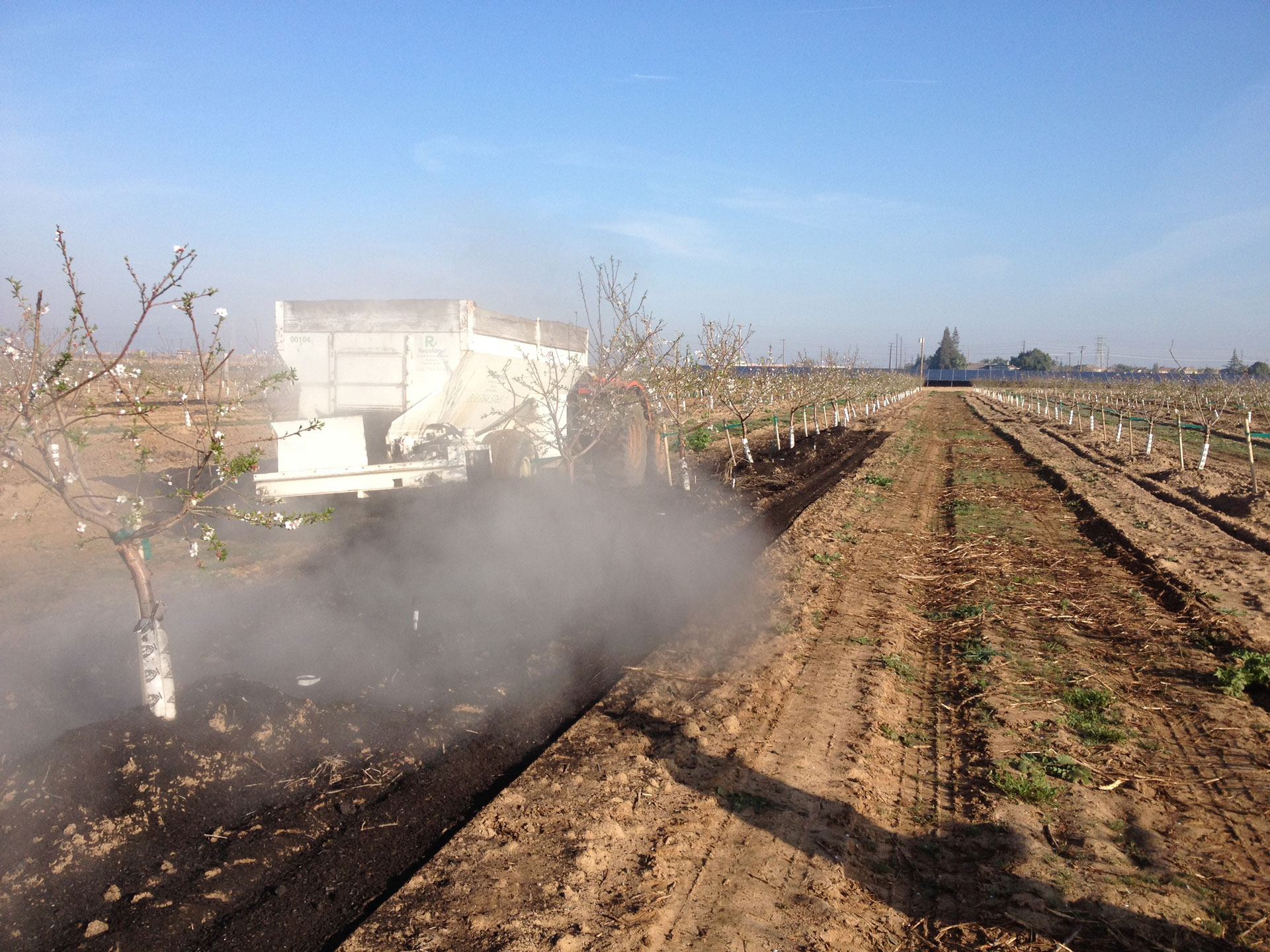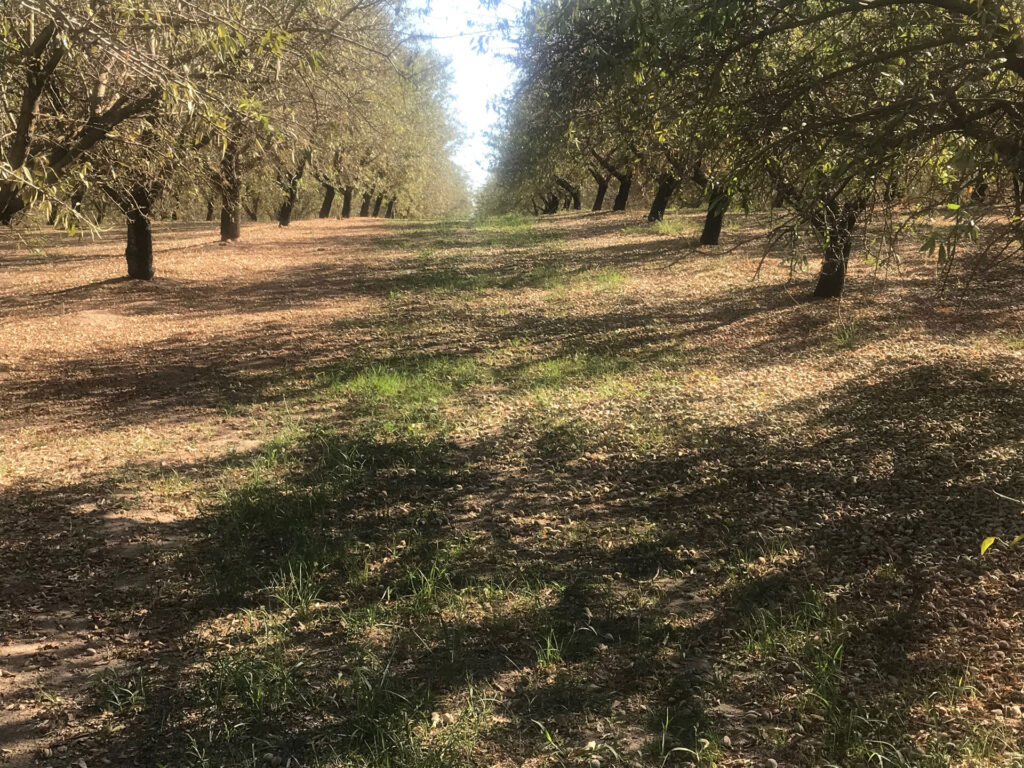
Sustaining agricultural production through climate change, prolonged drought and economic pressure largely depends on the soil’s ability to support high-yielding crops under increasing stress and resource scarcity. California’s almond industry garners public scrutiny for its high water consumption and environmental impact. Yet, growers have installed microsprinklers and other irrigation system upgrades, successfully decreasing water usage by 33% since 1990. The Almond Board pledged to decrease consumption another 20% by 2025. Meeting water conservation goals requires a multipronged approach, and soil health management can contribute to the puzzle.
While water usage rightly receives public attention, the environmental impacts incurred by poor soil quality also deserve urgent consideration. Marginal cropland with low organic matter maintains productivity by spoon feeding fertilizer and water. Compaction, salt accumulation, nutrient imbalances and soilborne diseases compromise yield and increase the amount of water, fertilizer and pesticides needed to maintain yields. Ag chemicals runoff into surface waters and leach down to aquifers. Nitrous oxide and methane emissions contribute to climate change. Yet, food production and environmental protection goals do not need to remain at odds. Adopting management strategies that increase soil organic matter can slowly transform agricultural lands to provide significant ecological benefits while promoting crop health and vigor.
Nut crops may require a lot of water, but soil conservationists advocate farming systems designed around permanent crops that offer greater carbon sequestration potential than heavily tilled annuals. Tillage depletes organic matter by disturbing the ecology and exposing soil to the air. Microbes previously limited by low oxygen concentration suddenly accelerate growth, oxidizing soil carbon faster than it can be fixed. Annual net carbon loss ensues, compromising soil structure and fertility. Orchard and vineyard soils can remain undisturbed for many years, allowing enough time to accumulate organic matter and reap the environmental and agronomic benefits.
Organic Matter Does It All
Organic matter improves almost every aspect of soil health, including physical, chemical and biological characteristics. Organic matter builds soil structure, the physical architecture that facilitates movement of water and air through the soil profile. Organic matter adheres to clay surfaces, forming organo-mineral colloids that prevent further decomposition. Mineral and organic matter complexes bind together forming stable soil aggregates separated by pore spaces that hold water and air.
Soil with stable aggregation and plenty of porosity prevents runoff by allowing fast water penetration and infiltration during heavy rainfall or irrigation. Organic matter and improved structure increase the soil’s water holding capacity, allowing the field to retain more water to sustain the crop during drought. Organic matter’s adhesive properties also prevent water and wind erosion, conserving topsoil while protecting the surrounding environment from nitrate, phosphorus and pesticide residue contamination. Excess water captured during major storms can replenish aquifers rather than runoff into streams, eroding the landscape along the way.
Organic matter’s chemical characteristics provide important benefits to crop production by buffering pH and increasing nutrient availability. Plant, animal and microbial remains decompose into carbon molecules with both positive and negative charge sites. The reactive sites attract and hold cations, such as hydrogen, calcium, potassium and magnesium, and anions, including hydroxide, nitrate, borate and molybdate. Binding with organic matter prevents essential nutrients from leaching to groundwater or precipitating out of soil solution with other minerals. Ions buffer into or out of soil solution to maintain chemical equilibrium, keeping pH near neutral and replenishing nutrient concentrations in response to plant absorption.
The living fraction of soil organic matter drive all of the activity contributing to healthy soil development. Fungal networks, beneficial bacterial populations, earthworms and more contribute to carbon cycling and organic matter fixation. Micro and macroorganisms decompose raw organic matter, returning essential elements to plant available form. Sticky substances exuded by microbes bind soil particles into aggregates and earthworms burrow through soil, creating channels for water and air flow. Microbial metabolites chelate micronutrients, delivering iron, zinc and other elements to roots in plant-available forms. Beneficial fungi extend the crop’s root system, exchanging water and nutrients for photosynthate and signaling when to activate stress defense mechanisms. Microbial biomass also provides nutrient storage, releasing plant-available nitrogen, phosphorus and other elements as populations turn over.
Feed the Soil its Carbon
Microbial activity, nutrient cycling, and structure development require carbon. Almonds and other tree crops feed the microbiome by sending photosynthate down to the rhizosphere, but significant improvement in soil quality requires more biomass. Feeding microbial populations by growing cover crops and applying compost or mulch can help achieve net carbon gain, initiating the processes that build organic matter and improving agricultural sustainability. Soil structure and beneficial microbial ecology take time to develop.
During the first few years of cover cropping, the orchard might require more water and fertilizer to establish a robust cover crop stand without jeopardizing the crop’s access to sufficient moisture and nutrition. Over time, the investment pays off. Incremental increases in organic matter ramp up the soil’s capacity to sustain diverse, active microbial populations. Increased microbial activity accelerates humus formation and the other beneficial soil characteristics follow. Improved nutrient availability, soil moisture and beneficial microbes can improve tree health, reducing symptoms of micronutrient deficiency, drought and salinity.

Measurable improvements in water holding capacity, bulk density and nutrient availability may take several years to develop. Soil type, management practices, weather, water, fertilizer and many other factors influence organic matter accumulation and soil health. While some soils may respond quickly, others resist organic matter fixation. Very sandy soils lack the clay particles that bind and stabilize organic matter, preventing accumulation. The type of organic matter added to the system also impacts results. Some studies show better water-stable aggregate formation after cover cropping compared with compost application, but the effect varies with both soil type and cover crop species.
Further research on interactions between cover crops, soil types, and microbial response will improve our ability to adjust management practices to suit the conditions on each ranch. In the meantime, feed the soil microbiome with diverse carbon sources from cover crop mixes, mulch, and compost. Send soil samples to labs to check for parasitic nematodes and other soil borne disease. Select cover crop species that do not host the pathogens present in the field. Consider other drawbacks, such as gopher population growth in response to legumes or winter frost exacerbation when soils remain colder under cover crops.
UCCE advisors, cover crop seed companies and experienced growers can provide guidance on cover crop establishment and may suggest options to avoid some of the pitfalls. Comprehensive soil chemical analysis can guide fertilizer applications and labs providing soil health diagnostics can help measure change after implementing new soil building practices. Field evaluations can measure changes in structure, water infiltration rate and erosion potential.
Highly productive, carefully managed orchards might not show any changes in yield or crop quality, but better soil health may allow growers to decrease water and fertilizer use while maintaining productivity. Increasing organic matter and improving soil health takes time and experimentation, but long-term changes in land management provide an array of environmental benefits, including water conservation, erosion prevention and resiliency against extreme climatic stress. California’s almond orchards and other permanent crops provide a critical opportunity to sequester carbon and build healthy living soils that will remain productive and efficient far into the future.










